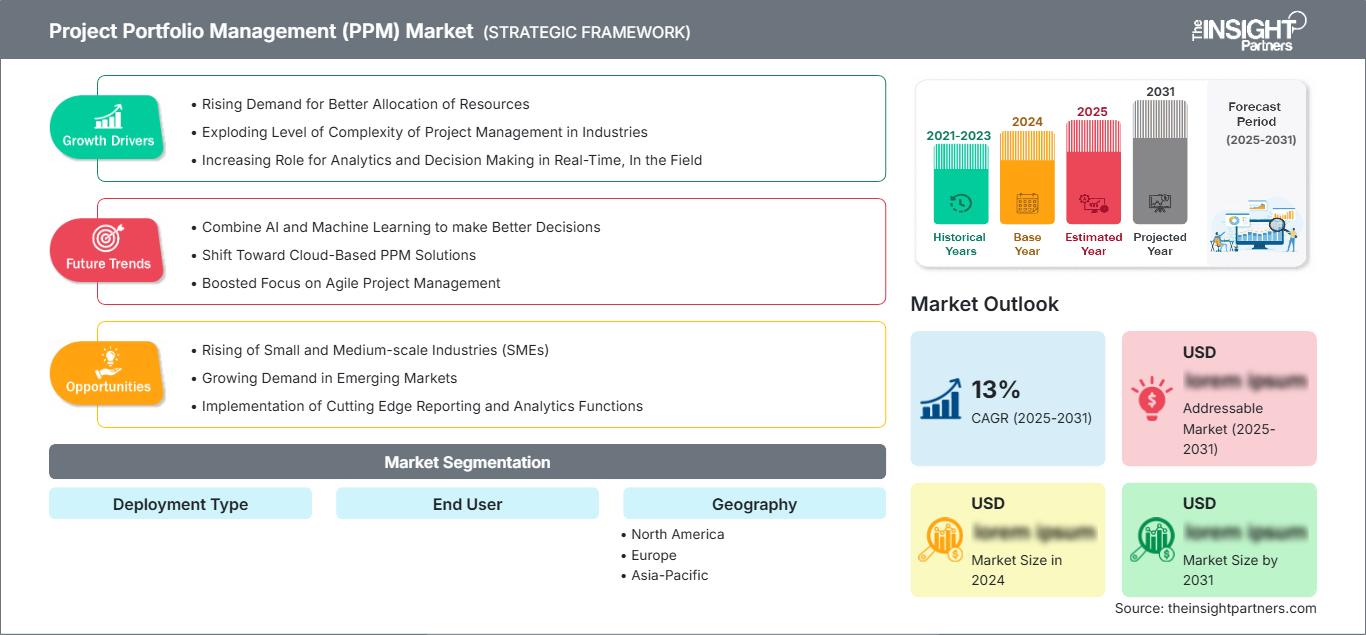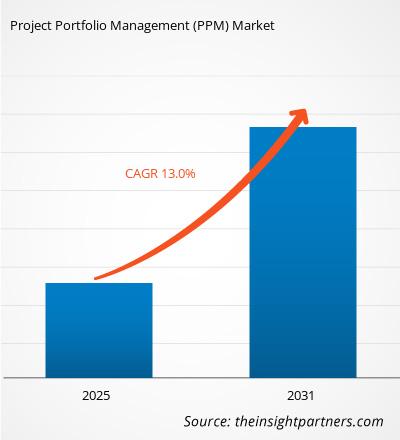Si prevede che il mercato del Project Portfolio Management (PPM) raggiungerà i 12,21 miliardi di dollari entro il 2031. Si prevede che il mercato registrerà un CAGR del 9,2% nel periodo 2025-2031.
Il rapporto sul mercato del PPM segmenta il mercato del Project Portfolio Management (PPM) in base al tipo di soluzione, alla modalità di distribuzione, alle dimensioni dell'organizzazione e al settore verticale. Offre un quadro regionale completo dei mercati e dei paesi per una visione globale. Le stime dei prezzi di mercato per regione sono presentate in dollari statunitensi (US$), le stime del CAGR mostrano l'andamento del mercato. Questo rapporto offre un'analisi olistica delle condizioni di mercato, dei trend di crescita e della concorrenza per regioni e segmenti.
Scopo del rapporto
Il rapporto sul mercato del Project Portfolio Management (PPM) di The Insight Partners mira a descrivere il panorama attuale e la crescita futura, i principali fattori trainanti, le sfide e le opportunità. Ciò fornirà approfondimenti a vari stakeholder aziendali, come:
- Fornitori/produttori di tecnologia: per comprendere le dinamiche di mercato in evoluzione e conoscere le potenziali opportunità di crescita, consentendo loro di prendere decisioni strategiche informate.
- Investitori: per condurre un'analisi completa delle tendenze in merito al tasso di crescita del mercato, alle proiezioni finanziarie del mercato e alle opportunità esistenti lungo la catena del valore.
- Organismi di regolamentazione: per regolamentare le politiche e le attività di polizia nel mercato con l'obiettivo di ridurre al minimo gli abusi, preservare la fiducia degli investitori e sostenere l'integrità e la stabilità del mercato.
Tipo di distribuzione della segmentazione del mercato della gestione del portafoglio progetti (PPM)
Utente finale
Potrai personalizzare gratuitamente qualsiasi rapporto, comprese parti di questo rapporto, o analisi a livello di paese, pacchetto dati Excel, oltre a usufruire di grandi offerte e sconti per start-up e università
Mercato della gestione del portafoglio progetti (PPM): Approfondimenti strategici

-
Ottieni le principali tendenze chiave del mercato di questo rapporto.Questo campione GRATUITO includerà l'analisi dei dati, che vanno dalle tendenze di mercato alle stime e alle previsioni.
Fattori di crescita del mercato del Project Portfolio Management (PPM)
- Crescente domanda di una migliore allocazione delle risorse: le organizzazioni si stanno anche orientando verso soluzioni di Project Portfolio Management (PPM) per ottimizzare l'utilizzo delle risorse su diversi progetti. Le soluzioni PPM offrono inoltre informazioni sulle risorse disponibili e sulle esigenze del progetto, consentendo di allocare competenze e risorse in modo efficiente. Oltre il 65% delle aziende afferma di ottenere di più dai progetti gestendo meglio le proprie risorse con la soluzione PPM, e questo è anche uno dei motivi per cui il mercato è in forte crescita.
- Livello di complessità crescente del Project Management nei settori: con la crescente complessità della gestione dei progetti, con un numero sempre maggiore di progetti simultanei e distribuiti e team distribuiti geograficamente, gli strumenti PPM hanno acquisito maggiore importanza. Le soluzioni PPM automatizzano i flussi di lavoro e migliorano il lavoro di squadra, entrambi aspetti importanti nelle aziende. Oltre il 70% delle aziende con più progetti contemporaneamente considera il PPM essenziale e questo si traduce in un aumento delle dimensioni del mercato e della sua adozione.
- Ruolo crescente dell'analisi e del processo decisionale in tempo reale, sul campo: analisi nei prodotti PPM, che forniscono dati in tempo reale ai project manager, consentendo loro di prendere decisioni informate in tempo reale. Poiché il software PPM consente di prendere decisioni in tempo reale, i progetti subiscono meno ritardi e vengono completati più spesso. Oltre il 50% delle aziende che utilizzano dati in tempo reale registra anche una consegna più rapida dei progetti: questo è il potere dell'analisi nell'incrementare la quota di mercato del PPM.
Trend futuri del mercato del Project Portfolio Management (PPM)
- Combinare intelligenza artificiale e apprendimento automatico per prendere decisioni migliori: anche i casi d'uso di intelligenza artificiale e apprendimento automatico nei sistemi PPM sono in aumento. Questi strumenti consentono l'elaborazione dei dati e forniscono previsioni in base alle quali è possibile prendere decisioni e gestire il rischio. Entro il 2026, quasi il 40% delle soluzioni PPM includerà funzionalità di intelligenza artificiale/apprendimento automatico (IA/ML), che svolgeranno un ruolo fondamentale nella crescita del mercato, poiché le aziende cercheranno di ottenere risultati migliori nei progetti.
- Passaggio a soluzioni PPM basate su cloud: il PPM nel cloud è un'opzione in evoluzione perché più flessibile, scalabile e accessibile. Queste soluzioni consentono ai team di lavorare insieme in tempo reale da qualsiasi luogo, il che è perfetto per le aziende multinazionali. Secondo i sondaggi, oltre il 60% delle aziende prevede di esternalizzare le proprie applicazioni PPM sul cloud nei prossimi 5 anni, a dimostrazione di un radicale cambiamento del mercato.
- Maggiore attenzione alla gestione agile dei progetti: la gestione agile dei progetti è ormai diffusa in molti settori e anche i sistemi PPM si stanno adattando agli approcci agili. Questo modello è anche una risposta ai tempi di progetto accelerati e alla pianificazione iterativa. Si prevede che gli strumenti PPM compatibili con Agile detengano un'enorme quota di mercato entro il 2025, poiché quasi la metà delle aziende desidera utilizzare pratiche Agile per essere più flessibile e reattiva ai cambiamenti di progetto.
Opportunità di mercato per il Project Portfolio Management (PPM)
- Esplosione delle piccole e medie imprese (PMI): le piccole imprese utilizzano gli strumenti PPM più che mai per diventare più efficienti nei progetti e competere con le organizzazioni più grandi. Con soluzioni per le PMI convenienti e flessibili all'orizzonte, c'è ampio spazio di crescita in questo settore. Oggigiorno, quasi il 45% delle PMI afferma di desiderare una migliore gestione dei progetti, e questo farà crescere il mercato PPM nelle organizzazioni più piccole.
- Crescente domanda nei mercati emergenti: anche nei mercati in rapida digitalizzazione come l'Asia-Pacifico e l'America Latina, la domanda di soluzioni PPM è in aumento. Con la crescita dei settori industriale e IT in queste aree, la domanda di strumenti di project management efficaci è in aumento. Molte persone in India e Brasile aumenteranno l'utilizzo di PPM, poiché le loro attività basate su progetti cresceranno di oltre il 20% nel prossimo decennio.
- Implementazione di funzioni di reporting e analisi all'avanguardia: poiché le aziende si affidano sempre più a decisioni basate sui dati, sono alla ricerca di funzionalità di reporting e visualizzazione più sofisticate nelle soluzioni PPM. Più report potenti sono disponibili in un sistema PPM, maggiori saranno le opportunità di vedere l'andamento dei progetti e come vengono utilizzate le risorse. Questa funzionalità rappresenta una grande opportunità per i fornitori di soluzioni PPM, poiché oltre il 55% delle organizzazioni afferma che la visualizzazione dei dati è fondamentale per la gestione dei progetti.
Mercato della gestione del portafoglio progetti (PPM)
Le tendenze regionali e i fattori che influenzano il mercato del Project Portfolio Management (PPM) durante il periodo di previsione sono stati ampiamente spiegati dagli analisti di The Insight Partners. Questa sezione illustra anche i segmenti di mercato e la geografia della gestione delle malattie del ritmo cardiaco in Nord America, Europa, Asia-Pacifico, Medio Oriente e Africa, America meridionale e centrale.
Ambito del rapporto di mercato sulla gestione del portafoglio progetti (PPM)
| Attributo del rapporto | Dettagli |
|---|---|
| Dimensioni del mercato in 2024 | US$ XX Billion |
| Dimensioni del mercato per 2031 | US$ 12.21 Billion |
| CAGR globale (2025 - 2031) | 9.2% |
| Dati storici | 2021-2023 |
| Periodo di previsione | 2025-2031 |
| Segmenti coperti |
By Tipo di distribuzioneBy Utente finaleBy Geografia
|
| Regioni e paesi coperti |
Nord America
|
| Leader di mercato e profili aziendali chiave |
|
Densità degli operatori del mercato della gestione del portafoglio progetti (PPM): comprendere il suo impatto sulle dinamiche aziendali
Il mercato del Project Portfolio Management (PPM) è in rapida crescita, trainato dalla crescente domanda degli utenti finali, dovuta a fattori quali l'evoluzione delle preferenze dei consumatori, i progressi tecnologici e una maggiore consapevolezza dei vantaggi del prodotto. Con l'aumento della domanda, le aziende stanno ampliando la propria offerta, innovando per soddisfare le esigenze dei consumatori e sfruttando le tendenze emergenti, alimentando ulteriormente la crescita del mercato.

- Ottieni il Mercato della gestione del portafoglio progetti (PPM) Panoramica dei principali attori chiave
Punti di forza
- Copertura completa: il rapporto analizza in modo esaustivo prodotti, servizi, tipologie e utenti finali del mercato del Project Portfolio Management (PPM), offrendo una panoramica olistica.
- Analisi degli esperti: il rapporto è redatto sulla base della conoscenza approfondita di esperti e analisti del settore.
- Informazioni aggiornate: il rapporto garantisce la pertinenza aziendale grazie alla copertura di informazioni e tendenze dei dati recenti.
- Opzioni di personalizzazione: questo rapporto può essere personalizzato per soddisfare le esigenze specifiche del cliente e adattarsi in modo appropriato alle strategie aziendali.
Il rapporto di ricerca sul mercato del Project Portfolio Management (PPM) può quindi contribuire a guidare il percorso di decodificazione e comprensione dello scenario del settore e delle prospettive di crescita. Sebbene possano esserci alcune valide preoccupazioni, i vantaggi complessivi di questo rapporto tendono a superare gli svantaggi.
- Analisi storica (2 anni), anno base, previsione (7 anni) con CAGR
- Analisi PEST e SWOT
- Valore/volume delle dimensioni del mercato - Globale, Regionale, Nazionale
- Industria e panorama competitivo
- Set di dati Excel
Report recenti
Testimonianze
Motivo dell'acquisto
- Processo decisionale informato
- Comprensione delle dinamiche di mercato
- Analisi competitiva
- Analisi dei clienti
- Previsioni di mercato
- Mitigazione del rischio
- Pianificazione strategica
- Giustificazione degli investimenti
- Identificazione dei mercati emergenti
- Miglioramento delle strategie di marketing
- Aumento dell'efficienza operativa
- Allineamento alle tendenze normative






















 Ottieni un campione gratuito per - Mercato della gestione del portafoglio progetti (PPM)
Ottieni un campione gratuito per - Mercato della gestione del portafoglio progetti (PPM)